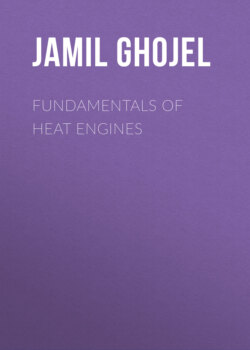Читать книгу Fundamentals of Heat Engines - Jamil Ghojel - Страница 52
1.3.5.2 Steady‐Flow Energy Equation
ОглавлениеConsider 1 kg of a working fluid element that may be a liquid, gas, or vapour, or any combination, and which is flowing steadily through a control volume (Figure 1.10). The fluid may possess energy in a number of forms between which conversions are possible:
1 Flow work or pressure work, given by pv.
2 Kinetic energy C2/2, due to the movement of the fluid element with velocity C.
3 Internal (thermal) energy u, due to the energy of the fluid molecules.
4 Potential or gravimetric energy, due to the height z above some datum line and given by zg.
5 Chemical, electrical, or magnetic energies may also be added, but these are not involved in the overwhelming cases encountered in thermal power cycles.
6 Heat Q may enter or leave the control volume.
7 Mechanical energy W may be added or removed, with some of the added energy being used to pump the fluid into the control volume or expel it out again.
8 Accumulated (stored) energy in the control volume as a whole ecv.
Figure 1.10 Steady‐state, steady‐flow control volume.
From the law of conservation of energy, the net energy input should be equal to the net energy output plus the energy that accumulates in the control volume. For properties per unit mass (specific properties denoted by lowercase letters) and consistent energy units (J) for all terms, we can write
Energy is not usually allowed to accumulate in the control volume of practical thermal power plants operating on thermodynamic cycles, and therefore the term ecv will be henceforward ignored and the energy equation is reduced to
(1.59)
Since specific enthalpy h = u + pv, Eq. (1.59) can be rewritten as
(1.60)
For a fluid flowing steadily at the rate of kg/s, the energy equation becomes
(1.61)
where
All terms in Eq. (1.61) have units of power ().
For a control volume with multiple flows into and out of the system, the general steady‐flow energy equation can be written as
(1.62)
